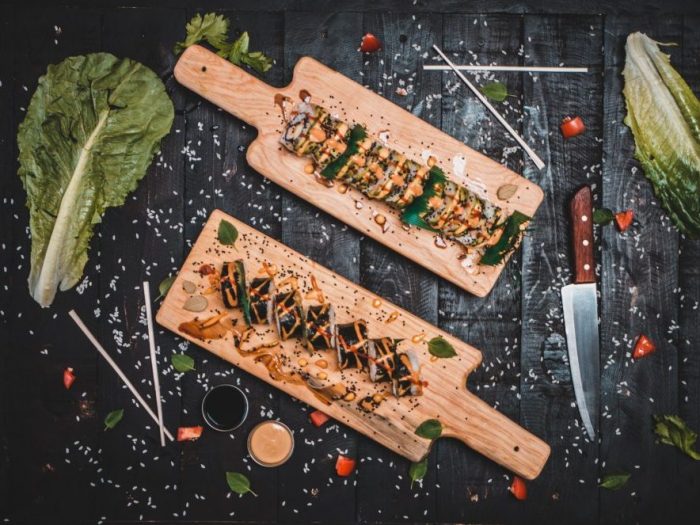
Japan is home to all the ingredients necessary to concoct a healthy lifestyle, but living for the health-conscious can quickly and easily empty your wallet. Nowhere is this more true than in Tokyo.
This article will primarily look at health in the context of nutrition and exercise on a budget in Tokyo, a problem that I initially encountered and one that has been known to not only challenge expats on a tight salary but so too native Tokyoites.
Implementing just a handful of judicious (and seemingly unorthodox) strategies can go a very long way in achieving personal best health and fitness in this amazing city, by relatively frugal means.
Gyms & Strength Training in Tokyo
While incidental cardiovascular exercise, specifically commuting by foot, is a free formality in Tokyo, strength training (the perfect complement to incidental physical activity for a healthy and robust body composition) isn’t as straightforward, nor economical.
24-hour gym memberships can easily cost in excess of Y10K per month, so it is little wonder Japan maintains its reputation as a running and yoga-obsessed nation; well, the monetary damage can at least be considered one plausible reason other than a culture that equates fitness with one’s body weight (or lack thereof)!
The ubiquity of Anytime Fitness (AF) franchises in Tokyo makes this gym the clear winner from a convenience standpoint, and while it is comparably cheaper than other gym franchises (think Gold’s) it is still undeniably expensive. However, purchasing an AF membership overseas prior to travelling or moving to Tokyo can translate to savings in the vicinity of 3K yen a month. For instance, my membership (arranged in Melbourne, Australia) costs ~Y5200/month when in Japan it is usually in excess of Y8000/month, and that’s excluding the other miscellaneous fees attached.
Gym memberships aren’t essential.
Unless you’re coming to Tokyo with a pre-existing gym membership, acquainting yourself with your neighbourhood’s outdoor workout settings is the way to go! Getting innovative with bodyweight strength training not only boasts an impressive expression of real world strength, it is inherently convenient and free of charge.
As a physiotherapist and strength coach, my philosophy very much espouses certain bodyweight resistance competencies as a necessary foundation to be laid before you consider heavy free weights. At least you should do bodyweight exercises in tandem with barbells and dumbbells; regardless of having the cash to afford gym expenses.
Exercise variations, progressions and regressions are endless in the realm of bodyweight training, catering to absolute novices as well as the seasoned athlete looking to up the ante. Besides that, YouTube offers a magnificent platform to learn the fundamentals via tutorials from credible coaches and health professionals. Daniel Vadnal of ‘FitnessFAQs’ is a reputable source of no-nonsense, perspicuous information pertaining to this form of training as well as injury prevention and management (Dan is a qualified physiotherapist).
Though ‘calisthenics’ or ‘street workout’ embodies a minimalist’s ideal, purchasing a set of portable gymnastics rings to take with to the playground is sensible to reap all that this training modality has to offer, increasing difficulty by virtue of stabiliser muscle recruitment. A good pair of wooden rings can be purchased online for an inexpensive ~Y4000 here and will last a lifetime.
And if you want to train alongside other like-minded individuals, the growing and cohesive community of ‘Street Workout Japan’ congregate regularly at various outdoor venues. You can either follow them on Instagram here, or enquire through the Tokyo Calisthenics community on Meetup here.
There are, of course, other fantastic group exercise initiatives run in Tokyo – most notably ‘Suns Out Guns Out (SOGO) Fitness’, which offers an array of different classes for free (or nearly free). This is a terrific community and starting place for those whom seek a regular exercise fix alongside a supportive group of individuals, and if structured strength training simply doesn’t appeal to you at this stage of your fitness journey.
Incidental Physical Activity Is Your Best Friend
Tokyo is renowned for having one of the most efficient and intricate train networks in the world, and with that public transport reputation comes a prodigious volume of incidental walking! And we should all know by now that, from a health standpoint, it is what we do in the remaining 23 odd hours each day (separate to our scheduled workout) that yields the most significant benefits.
Despite the inexorable number of steps we all notch in this densely populated city, most Tokyoites are paradoxically lazy when it comes to taking the subway steps! Or so it would consistently seem from observation.
Where ever I go, I always make the effort to bypass the escalator and take the adjacent steps. It may seem inconsequential at first glance, but consider this: ascending a flight of 20 steps may expend ~10 calories, and roughly half of that for the descent (depending on other variables). If this is done 4 times a day, which is a very conservative estimate I would say for the average Tokyo commuter, that equates to ~60+ calories per day.
Over the course of 12 months, that is at least 21900 extra calories burned, which equates to 6.26lbs or 2.84kg of fat. Remember, these are only conservative estimations but significant nonetheless! Effortless fat loss, in my opinion. Don’t conform to the escalator line and lunge up those steps; they are there for good reason 😉
If you are fortunate enough to have snagged an affordable apartment in the heart of Tokyo, and everything is thus in relative proximity, consider purchasing a second-hand fixie (single-speed) bicycle to get around. Second-hand fixies can be bought for as little as 8,000 yen on Craigslist or, if you are hyper-attentive and lucky, free on the Mottainai Japan Facebook group. Opting for a single-speed bike adds that extra element of effort which, akin to regularly taking steps, can have a monumental effect in the long haul.
Money spent on even a mid-range bike is well worth the investment as you will likely break even after 1 month with the savings you would have spent on trains.
“Health Foods Are So Expensive, Good Nutrition is Impossible Here!”
Sure, you can subsist on the conbini’s onigiri (rice balls), or the pervasive Yoshinoya’s budget set menu, or even your local ramen eatery… all of which will temporarily fill the hole while most certainly not breaking the bank. A lot of people are content with doing just that.
But you are reading this article because you are health and fitness-conscious. You are cognisant of the need to consume adequate protein and micronutrients for thriving’s sake, not just empty calories to merely survive.
Meat and vegetables are indeed exorbitant commodities in Tokyo, posing a potential money pit for vegans and carnivores alike. In saying that, I will assume most reading this article are omnivores (i.e. indiscriminate to both animal and vegan foods) and so will outline strategies that can be universally applied.
Common tips perpetually circulated on the inter-web include discouraging purchasing groceries from convenience stores, and instead doing more substantial shops at the larger supermarkets which are generally cheaper, as well as purchasing fresh produce seasonally.
The convenience stores offer more value than their reputation would suggest. After all, they house in abundance what I believe to be the world’s most powerful ‘superfood’ and traditional Japanese food, natto – that’s right, the slimy, pungent, fermented soybean that foreigners tend to avoid at all costs.
It is a taste one should endeavour to acquire for all its amazing health benefits! I genuinely love the taste of it, and only want to inspire more foreigners to try it.
If ‘bang for buck’ foods exist, natto is unparalleled. It will set you back 50-100 yen (less than a dollar) for a three pack (~135g) at the convenience store and is famous in the nutritional sphere for its well-roundedness: excellent source of high quality non-animal protein; nourishes our ‘good’ gut bacteria; unmatched vitamin K2 content which is vital for an array of markers including bone and cardiovascular health; provides complex carbohydrates; countless other micronutrients…
Ah, the list goes on and on.
For the uninitiated, I would suggest consuming natto the way natives do for a traditional Japanese ‘washoku’ breakfast: crack and mix one or multiple raw egg(s) into cooked brown rice, then add natto! Enjoy this nutrient-dense, satiating, cheap meal.
If you are not willing to try this Japanese staple because of a preconceived idea of how it tastes, I implore you to become more open-minded to the multitude of unique foods available in this incredible island nation.
“Preparing Meals at My Tokyo Apartment is So Inconvenient!”
You’re right, it is. And that’s precisely why I would encourage you to only prepare 1-2 large meals in your apartment each day.
If you weren’t already aware of the mounting research supporting fewer daily meals, you will be hereafter. Long debunked is the myth of ‘stoking the metabolism’ by eating around the clock. In fact, regular bouts of abstaining from food (i.e. intermittent fasting (IF)) is immensely healthy.
And while the thought of foregoing breakfast or other socially conditioned meals may strike you as unfathomable at first, it is simply a matter of habit formation. Let’s not forget that fasting is FREE, unlike many a dietary supplement that robs you for no discernible return.
Restricting one’s eating window each day to 10 hours or, ideally less, may promote anti-cancerous, anti-ageing, anti-diabetic effects; not to mention significant fat loss. And on top of that, creating a buffer of energy for later in the day is socially practical since this is when most social activity takes place.
Tokyo is the perfect setting to implement IF because innumerable other things will keep you stimulated during the fast, and all the incidental physical activity you’ll be doing serves to amplify fasting’s effects. Brooding over food needn’t take place.
However, if I still haven’t totally sold this practice to you yet, opting for a wholesome breakfast as above before the day is fine too! Just try to delay it a few hours after waking up.
Alternatively, cheap snack options that can be eaten as a means to transitioning to uninterrupted fasts include Meiji’s dark chocolate (minimum 70% cacao) and blueberries from the convenience store. High in antioxidants, inexpensive, readily available and effective at blunting the appetite.
“What About Protein, And Won’t I Lose Muscle Fasting?!”
Much research in recent years has demonstrated that protein consumption in the context of a 24-hour day is the most important consideration pertaining to muscular development and sparing.
With that said, and given the feasibility of preparing only one large meal a day in Tokyo, I recommend satisfying much of your daily protein quota within that one meal.
A 500g pack of raw chicken breast can be bought for ~500yen at, you guessed it, the omnipresent conbini! This yields 115g of protein, meeting a petite female’s day’s quota and being well on the way to an average-sized male’s daily protein needs.
In line with the scientific literature, 1 gram of protein per pound of bodyweight is a solid target for most health-conscious folk that partake in regular physical training and care about muscle preservation and ultimately health.
An example of a BIG, nutrient-dense meal I would prepare on a budget in Tokyo consists of: pan-fried chicken breast (in olive oil) OR tuna sashimi, several packs of natto, eggs, spinach, and either home-cooked sweet potato or yakiimo. Yakiimo is the delectable roasted sweet potato sold during winter and autumn. Don Quixote sells it for roughly 100 yen per 100g – super cheap for such a tasty and nutritious food.
Altogether, this meal is approximately 1000 yen and ticks a lot of boxes. And knowing a sizeable proportion of protein and micronutrients have been consumed alleviates much of the concern for potentially unhealthy indulgences that entice later in the day; it provides ‘wiggle room’ or insurance, if you like.
An Example Structure of A Week Day in Tokyo
6am: Wake Up, Shower etc.
7am: Walk to café or work location, drink coffee
8am-12pm: Work (interspersed with bouts of walking/stretching)
12:30pm: Breakfast (large pre-prepared meal as above)
1:30-4pm: Work
5pm: Snack (optional) then Training/Exercise
6:30pm: Dinner + Socialising With Friends
Health Is Frugally Attainable in Tokyo
Tokyo living can be expensive, but attaining the intangible wealth that is our health here is clearly manageable on a budget. Ultimately, our health hinges on lifestyle habits that are borne from intrinsic motivation; and Tokyo is a city that is indisputably conducive to such a salubrious lifestyle! Implement a few of the unconventional strategies outlined in this article and let us know how you go. Written by Jonny Souter.













